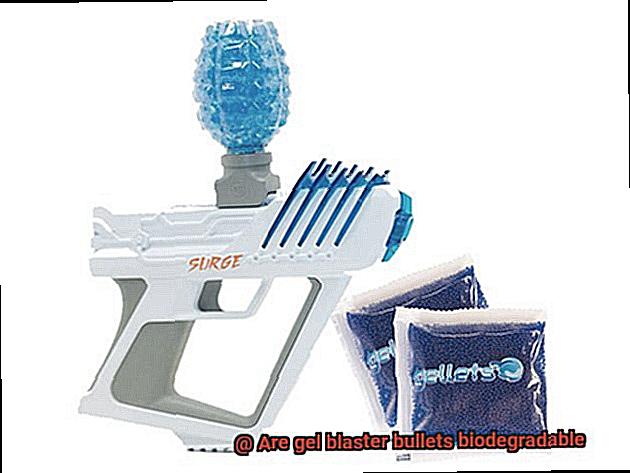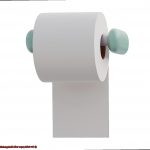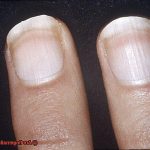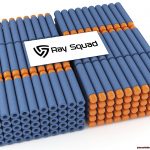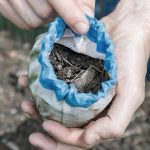As gel blaster guns continue to gain popularity among firearm enthusiasts, it’s essential to consider the impact they have on our environment. While these guns offer a realistic shooting experience at a low cost and with relative safety, concerns are growing about the potential environmental impact of their bullets.
Many gel blaster bullets claim to be biodegradable, but the validity of these claims is still up for debate. That’s why we’re here to answer the question that every gel blaster enthusiast has on their mind – Are gel blaster bullets truly biodegradable?
In this blog post, we’ll delve into the science behind biodegradability and explore the environmental impact of gel blaster bullets. We’ll also address any misconceptions surrounding their biodegradability and discuss whether or not they pose a threat to our planet.
By the end of this post, you’ll have a better understanding of the pros and cons of using biodegradable gel blaster bullets and alternative options available to reduce ecological pollution. So sit tight and keep reading to learn more about how you can minimize your impact on the environment while still enjoying your favorite hobby.
What are Gel Blaster Bullets?
Contents
- 1 What are Gel Blaster Bullets?
- 2 Types of Polymer Materials Used in Gel Blaster Bullets
- 3 Advantages of Biodegradable Gel Blaster Bullets
- 4 Disadvantages of Non-Biodegradable Gel Blaster Bullets
- 5 Factors Affecting the Biodegradation of Gel Blaster Bullets
- 6 Responsible Disposal of Gel Blaster Bullets
- 7 Conclusion
You might want to consider gel blaster guns, which shoot small, water-absorbing polymer spheres called gel blaster bullets at high speeds. These colorful little balls can be purchased in bulk online or at specialty stores and come in various sizes and colors.
Gel blaster bullets are a safer alternative to traditional airsoft or paintball ammunition because they are made of a soft, squishy material. They are less likely to cause injury upon impact, making them a popular choice for people who want to enjoy the thrill of combat-style games without risking their safety.
Another advantage of gel blaster bullets is that they dissolve upon contact with water, making them less likely to cause damage to property or the environment. However, it is important to note that some gel blaster bullets are not biodegradable and may take years to break down completely. This could lead to pollution and environmental damage if they are not disposed of properly.
Fortunately, some manufacturers have started producing gel blaster bullets using biodegradable polymer materials such as polylactic acid (PLA) and polyhydroxyalkanoates (PHA). These materials can break down naturally into non-toxic compounds over time while minimizing their impact on the environment.
When purchasing gel blaster bullets, it is essential to verify the specific type of polymer material used and dispose of them responsibly by following local regulations or recycling programs.
Types of Polymer Materials Used in Gel Blaster Bullets
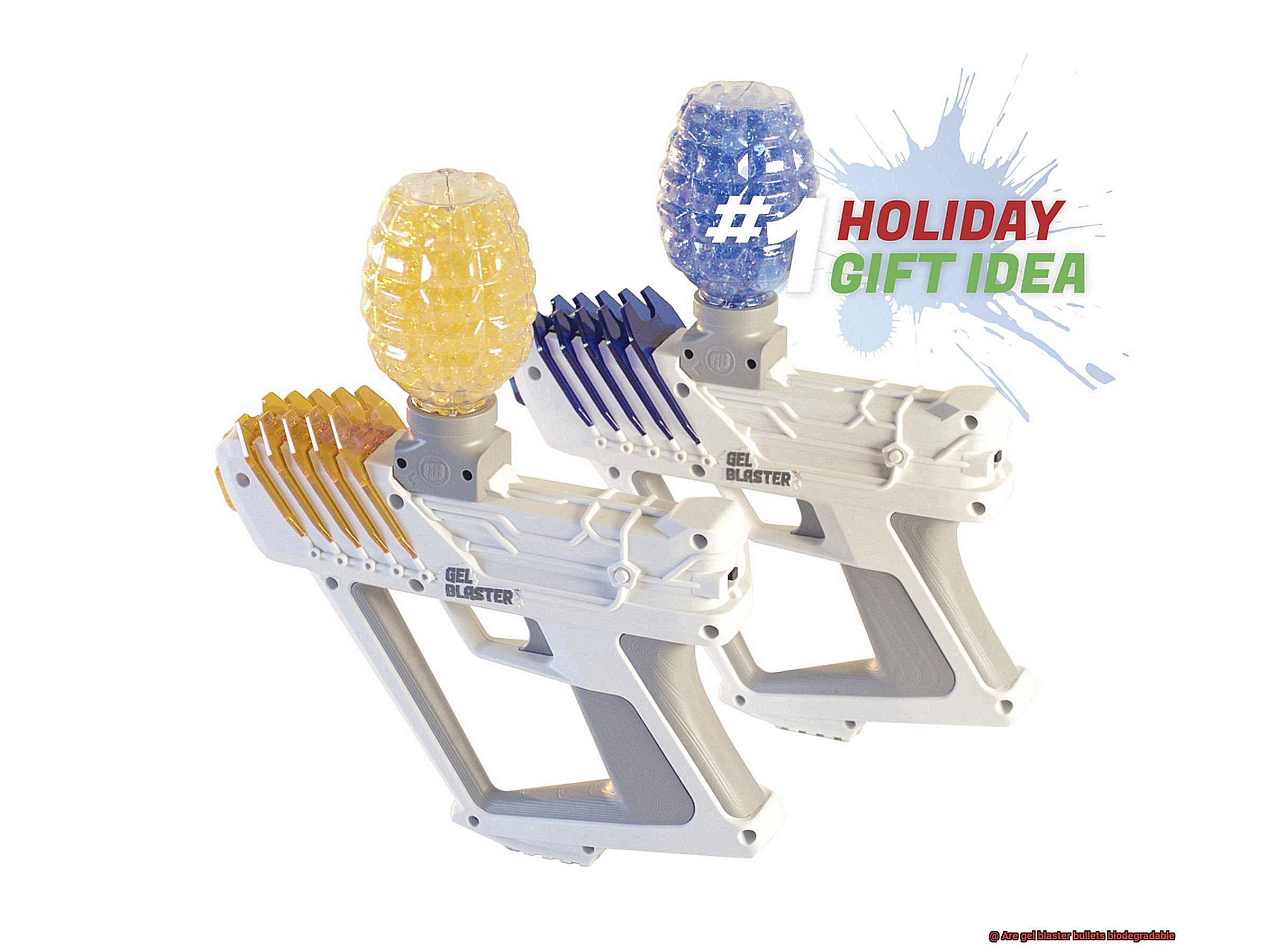
Gel blaster bullets are a popular choice for those who enjoy tactical games and simulations. As an expert in the field, I know that the type of polymer material used in these bullets can have a significant impact on their biodegradability.
Polymer materials are synthetic compounds that can be molded into various shapes and forms. One common polymer material used in gel blaster bullets is polyvinyl alcohol (PVA). PVA is a water-soluble polymer that can dissolve in water, making it an environmentally friendly option for gel blaster bullets. However, PVA may not be as durable as other polymer materials, which could affect the performance of the bullets.
Another water-soluble and biodegradable polymer used in gel blaster bullets is polyacrylamide (PAM). PAM is known for its ability to absorb water and retain moisture, making it a popular choice in agriculture and wastewater treatment. However, like PVA, PAM may have lower durability compared to other polymer materials.
On the other hand, gel blaster bullets made from non-biodegradable polymers like polystyrene (PS) and acrylonitrile butadiene styrene (ABS) do not decompose naturally. These types of polymers are commonly found in plastic products and can contribute to environmental pollution if not disposed of properly.
When it comes to choosing the right type of gel blaster bullet for you, it’s important to consider the environmental impact. Water-soluble polymers like PVA and PAM are more eco-friendly options as they break down over time and won’t harm the environment. However, they may not be as durable as non-biodegradable options like PS and ABS, which can affect their performance.
Ultimately, responsible disposal of your gel blaster bullets is essential to minimize their impact on the environment. Whether you choose biodegradable or non-biodegradable options, proper disposal is key.
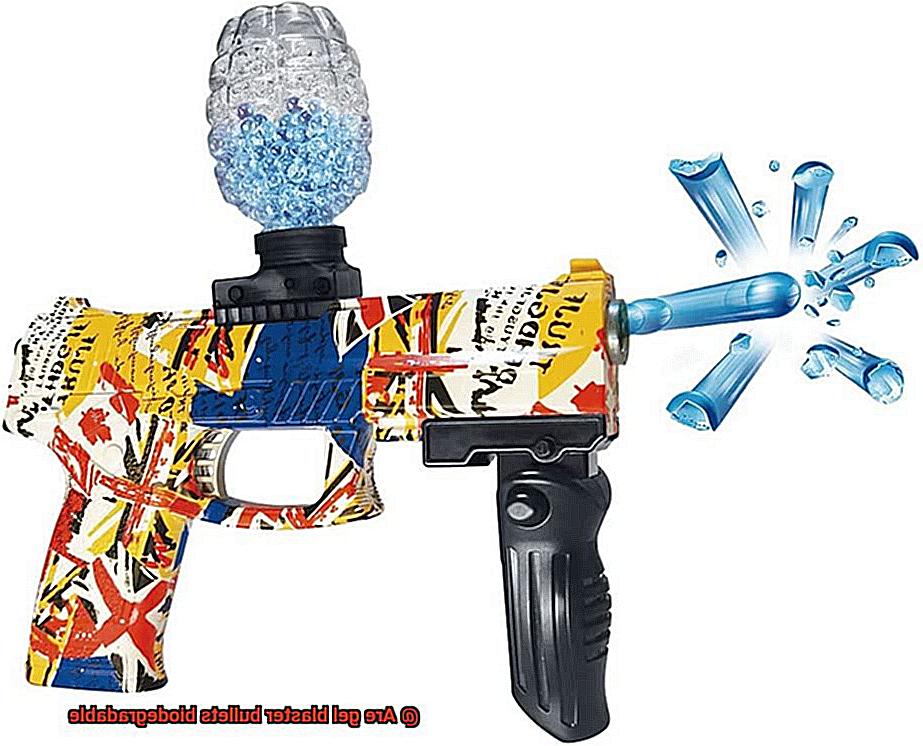
Advantages of Biodegradable Gel Blaster Bullets
Biodegradable gel blaster bullets have numerous benefits that far outweigh their non-biodegradable counterparts.
First and foremost, biodegradable bullets are environmentally friendly. Unlike traditional bullets that can accumulate in soil or water bodies, these bullets break down naturally when exposed to the elements. This results in less pollution and a safer environment for everyone. The planet will thank you for choosing this eco-friendly option.
Secondly, biodegradable gel blaster bullets are much safer for wildlife and pets. Non-biodegradable bullets can pose a serious threat to animals or pets if left behind after use. However, biodegradable bullets break down into harmless organic matter, eliminating this risk entirely. You can use your blaster with peace of mind knowing that you are not putting any animals or pets in harm’s way.
Thirdly, biodegradable gel blaster bullets are cost-effective in the long run. Although they may be slightly more expensive initially, they save money over time by reducing the need for costly clean-up efforts and potential fines or penalties associated with environmental damage caused by non-biodegradable bullets. You will be doing a good deed for both the environment and your wallet.
Lastly, using biodegradable gel blaster bullets can improve your reputation as an individual or company. By choosing to use environmentally friendly ammunition, you can demonstrate your commitment to sustainability and responsible practices. This can attract customers or stakeholders who value these principles. It’s a win-win situation.
In conclusion, switching to biodegradable gel blaster bullets is a no-brainer. With their environmental friendliness, safety for wildlife and pets, cost-effectiveness in the long run, and improved reputation, there is no reason not to make the switch today. Join the growing community of individuals and companies committed to making a positive impact on the environment.
Disadvantages of Non-Biodegradable Gel Blaster Bullets
Let’s start with the most obvious disadvantage – environmental pollution. Non-biodegradable gel blaster bullets are made of plastic and do not break down naturally, which means they can remain in the environment for hundreds of years, causing harm to wildlife and ecosystems. Imagine leaving a piece of gum on the sidewalk – it might not seem like a big deal at first, but over time, that gum accumulates and becomes a significant nuisance. Non-biodegradable gel blaster bullets are no different – they accumulate and can cause significant harm to our environment.
Another disadvantage is that non-biodegradable gel blaster bullets are not eco-friendly. If you’re someone who cares about the environment and wants to reduce your carbon footprint, using non-biodegradable gel blaster bullets might make you feel guilty. It’s like driving a gas-guzzling car when you know there are more sustainable options available – it just doesn’t align with your values.
In some areas, non-biodegradable gel blaster bullets may also be illegal due to their potential harm to the environment. This can limit your options for purchasing bullets and force you to switch to biodegradable alternatives. Plus, even if they’re not illegal in your area, you might face judgment from others who are more environmentally conscious.
Finally, non-biodegradable gel blaster bullets may end up being more expensive in the long run. Although they might cost less initially than their biodegradable counterparts, the cost of cleaning up the environment and replacing damaged equipment can add up over time. Biodegradable gel blaster bullets, on the other hand, break down naturally and don’t require any additional costs for cleanup or replacement.
Factors Affecting the Biodegradation of Gel Blaster Bullets
However, several factors can influence their rate of biodegradation, which is crucial to minimize their environmental impact. Let’s explore these factors further.
Environmental conditions such as temperature, humidity, and sunlight exposure play a significant role in the rate at which the polymer material breaks down. The hotter and drier the environment, the faster the material may break down due to increased UV radiation exposure from the sun. Conversely, colder and wetter conditions may slow down the biodegradation process.
The composition of the polymer material also affects its biodegradability. Some polymers are more resistant to degradation than others, and additives or fillers can further hinder biodegradation. The size and shape of the bullets are also important factors, with smaller particles breaking down more quickly than larger ones.
Lastly, other materials present in the environment can affect the biodegradation of gel blaster bullets. If left in soil contaminated with pollutants, their ability to break down may be hindered. Similarly, if they are left in water polluted with oil or other substances, their biodegradation may be slowed or stopped.
Therefore, it is vital to understand these factors and take steps to minimize their impact on the environment. By doing so, we can ensure that these materials break down faster and reduce their overall environmental impact.
In conclusion, while gel blaster bullets are designed to be biodegradable, several factors can influence their rate of decomposition. By taking measures to reduce their impact on the environment, we can ensure a more sustainable future for ourselves and our planet.
Responsible Disposal of Gel Blaster Bullets
Did you know that even though gel blaster bullets are made of biodegradable materials such as starch and water, they still require proper disposal? These bullets can still pose a threat to wildlife and the environment if not disposed of correctly.
So, what are some responsible methods for disposing of gel blaster bullets? One option is to soak used gel blaster bullets in water for at least 24 hours, allowing them to fully dissolve. The resulting liquid can then be poured onto soil or plants as a natural fertilizer. It’s like a gift to Mother Nature – we’re returning the materials back to her in an eco-friendly way.
Another alternative is to place used gel blaster bullets in a compost bin or pile. Over time, the biodegradable materials will break down and help create nutrient-rich soil. It’s like giving back to the Earth in a way that benefits both us and future generations.
But it’s not just about disposing of used gel blaster bullets properly. What about unused or expired ones? It’s never safe to dispose of these dangerous items in regular household garbage or recycling bins.
Instead, take them to a hazardous waste facility for proper disposal. We all have a responsibility to take care of our planet, and this is just one small step we can take towards preserving our natural resources.
Conclusion
In summary, determining whether gel blaster bullets are biodegradable is not a straightforward matter. Even if manufacturers claim that their products are environmentally friendly, there is still some debate over the validity of these assertions. Additionally, several factors can affect the rate at which these bullets decompose.
Despite these complexities, using biodegradable gel blaster bullets offers numerous advantages over non-biodegradable ones. They are better for the environment, pose no risk to wildlife or pets, and ultimately save you money in the long run. Furthermore, choosing biodegradable options demonstrates your commitment to sustainability and responsible consumption.
To minimize the environmental impact of gel blaster bullets, it’s crucial to dispose of them carefully. Soaking them in water or placing them in a compost bin or pile are excellent ways to ensure they break down naturally. For unused or expired bullets, it’s best to take them to a hazardous waste facility for proper disposal.
As we continue to enjoy our favorite combat-style games with gel blaster guns, let’s be mindful of their impact on our planet. By selecting biodegradable options and disposing of them responsibly, we can make a positive difference for future generations.
